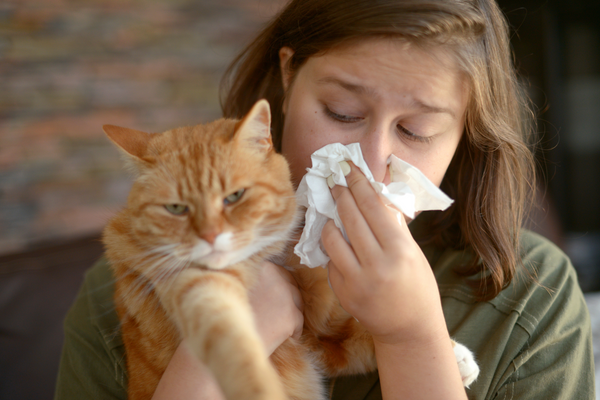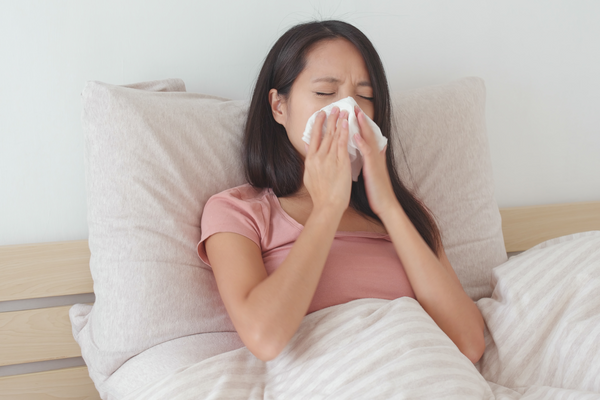5 Tips to Avoid Dust Mite Allergies While Decluttering

Whether you tackle it as a part of a downsizing effort, a New Year’s resolution, or simply to improve your home sanctuary for your overall health and well-being––decluttering can be an enriching task, especially for those with environmental allergies and asthma. After all, dust has fewer places to hide with less clutter around the home. And with the average American household collecting 40 pounds of dust every year (that’s roughly the weight of an English Bulldog!), tidying up can make a world of difference.
You see, where there is dust in a home, there are almost always dust mites. These pesky microscopic insects feed off the dead skin flakes we leave behind every day and trigger allergic reactions and asthma symptoms for at least 10% of the population.
While it’s scientifically impossible to have an entirely dust-free home, you can significantly reduce the level of dust inside your home (and reduce allergens as a result) by decluttering and dust-busting. The less clutter you have in your home, the easier it is to clean and maintain a healthy living space.
Related: How to Easily Reduce Dust Mites In Your Home
Follow these five tips to help avoid the miserable effects of dust mite allergies as you’re working to improve your home environment.
1. Have the Right Tools for the Job
Before you dive into decluttering and cleaning, gather your tools so you can remove dust quickly and effectively without triggering your allergy symptoms.
Here are the best dust-busting tools and supplies:
HEPA Vacuum
Vacuums with built-in high-efficiency particulate absorbing (HEPA) filters trap dust and dust mite allergens as you clean, rather than spewing them back into the air like traditional vacuums. After decluttering and cleaning, empty the vacuum’s canister outside so that the dust stays out of your home.
Microfiber Cleaning Cloths
Like traditional vacuums, standard dusting methods cause dust particles and dust mite allergens to go airborne. Instead, opt for microfiber cloths when it’s time to dust. Most microfiber cloths are eco-friendly, affordable, and excel in picking up dust. Always use a damp cloth to dust to ensure you trap dust particles. After use, toss your microfiber cloths into the washer and use them time and time again.
DustMiteX provides complete dust mite control and eliminates allergic reactions from dust mite populations in home environments. This colorless, odorless solution kills dust mites and their allergens from bedding, pet bedding, fabrics, and upholstered furniture. To apply, pre-clean surfaces by thoroughly vacuuming and then spraying DustMiteX evenly to dampen and penetrate surfaces.
For extra dust mite-busting cleaning power, reach for The Ecology Works Anti-Allergen Solution. You can either spray this 100% biodegradable plant- and mineral-based solution directly onto hard surfaces after cleaning to neutralize dust mite allergens or spray it onto a microfiber cloth and wipe. This solution can be used on both hard and soft surfaces. The Anti-Allergen Solution renders common household allergens (including dust mite allergens and pet dander) harmless to allergy sufferers.
Anti-Allergen Laundry Detergent
This 100% biodegradable allergist and dermatologist recommended laundry detergent gets rid of stains and grime while eliminating allergens. Perfect for use on clothing, linens, bedding, washable throw rugs, pet beds, stuffed animals, pillows, and more.
Related: The Golden Rules of Dusting
2. Suit Up For the Task
If you suffer from dust mite allergies or allergic asthma, consider wearing a dust mask (a 3M surgical mask with a particulate filter is ideal) and safety glasses while you tidy and clean. If possible, open the windows and turn the air-conditioning off while you work, as air-conditioning can move dust around and cause dust mite allergens to go airborne. If you have a particularly severe allergy to dust mites, consider hiring a cleaning professional or ask a friend or family member to help you tackle particularly dusty areas.
3. Dust and Vacuum Before Decluttering
After you’ve gathered your cleaning supplies and donned your dust mask, aim to remove as much dust as you can before you begin moving things around and decluttering. Start by dusting with a microfiber cloth dampened with Anti-Allergen Solution, and always clean high before you clean low. By starting at the top and working your way down, you’ll avoid having dust resettle on a freshly cleaned area. After you’ve dusted, use your HEPA vacuum to capture all the dust that’s fallen to the floor. After decluttering, dust and vacuum surfaces once again. It’ll be much easier and more satisfying the second time around, we promise!
4. Know Where Hidden Dust Lurks
As you’re decluttering and moving things around your home, keep in mind that some areas will be complete and utter dust festivals! Dust settles on shelves, behind and under furniture, on books, on curtains and blinds, and so on. As you’re removing clutter, keep your vacuum cleaner and cleaning cloth clean so that you can combat dust as you go.
5. Remove Lingering Dust
Once you’ve removed everything from your home that no longer “sparks joy,” it’s time to deep clean to remove any lingering dust. Remember to ventilate as you clean. Start by washing curtains, bedding, and washable throw rugs (launder according to the care instructions on each item’s tag), using The Ecology Works Anti-Allergen Laundry Detergent to remove dust mites and their allergens. Next, dust all surfaces again with a cloth dampened with the Anti-Allergen Solution.
Now, take some time to celebrate your refreshed home! You’ve earned it!
Have questions about reducing allergens inside your home? We have answers! The Ecology Works has been helping folks with asthma and allergies since 1993. We can help you select the products you need to live a better, allergen-free life. Check out our Instagram for more allergen-reducing tips. Need more help? Please feel free to Contact Us or message us on Facebook. No question is too small! We're here to help.




